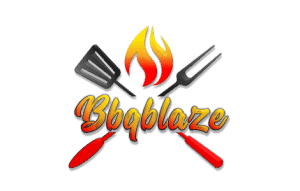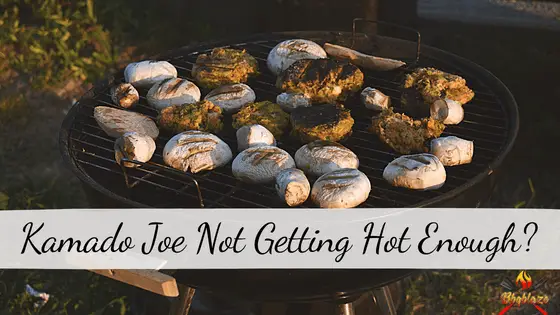If your Kamado Joe is not creating enough heat to get the juices flowing, it is not a build issue.
All Kamado grills have adequate infrastructure or features to allow for optimal temperatures.
Top grill men and women spend ample time cooking which sometimes lingers around very high temperatures.
The Kamado Joe not getting hot enough issue comes about due to issues with lumps of coal.
Other causes are linked to poor vent settings and of course not enough air in the chamber.
Getting the Kamado Joe to perform optimally requires some finesse and fine-tuning of the vents specifically.
Other small adjustments can be made before the grilling process begins.
Kamado Joe Not Getting Hot Enough? – Causes
The Kamado grill has exceptional build qualities allowing it to be used as a modern grill.
These features also facilitate grilling using methods that can only be coined as ancestral.
Here are a few reasons a Kamado Joe not getting hot enough scenario might occur.
Damp Coal
We all probably missed the heating or creating fire 101 classes at some point. Worry not though!
The thing to remember here is that water and fire don’t mix.
When using coal, ensure that all chunks are completely dry.
Wet lumps of coal might take longer to light up if at all.
Whether the coal is damp or simply cheap lump coal, the fire will not be as lit as you’d hoped or expected.
Restricted Airflow
Oxygen is the fuel that keeps fire burning or the catalyst in this case.
It means as long as the air is restricted to enter the chamber or dome, the Kamado Joe will not create nor retain adequate heat.
This is a problem that occurs for several reasons, including inadequate vent settings.
When the air is restricted, there are a few easy fixes mentioned herein.
Thermometer
At times, we don’t play it by ear, or by the nose!
The thermometer might be giving off the wrong readings while indeed the temperatures are okay.
Some thermometers might be reading off the wrong humidity or temperature due to other factors like wind, internal dirt, and grease restricting airflow or the correct amount of heat.
Also, you could have a damaged thermometer which is misleading you to believe you haven’t achieved optimal temperatures.
Firebox
The firebox might be extremely dirty and in dire need of cleaning.
Substances within this box can make it hard for coal and woodchips to produce enough heat for adequate grilling.
Having this heat transferred to other parts of the dome becomes harder still.
Many grill men spend ample time cooking and enjoying meals yet cleaning only the top of the dome. A firebox is equally as important as how the grill looks on the outside.
Inadequate Lighting Techniques
Three things make for a good temperature reading and a decent grilling session. These are heat, fuel, and coal.
If these three aren’t working hand-in-hand, something is bound to go wrong.
Most people use fire starters while others pull out a few newspapers and insert them into the bottom of the grill.
If the technique used to light up the grill is not apt chances of reaching optimal temperatures are slim.
The above-mentioned are the most common causes of the Kamado Joe not getting hot enough issues.
If you experience these problems occasionally, rest assured the solutions are quite simple.
However, what is important is remembering to use dry coal as opposed to damp or cheap coal to light the fires.
With that being said, here are surefire solutions or fixes to this problem.
Kamado Joe Not Getting Hot Enough – Fixes
These fixes allow you to fully enjoy the benefits that the Kamado continues to offer grill men worldwide.
Without reaching high or optimal temperatures, food doesn’t cook well and mouths don’t salivate either.
Replace Coal
If you have damp coal and it is not lighting up, dump it.
Use dry lump coal at all times to avoid such mishaps and delays while cooking.
It is also important to shop for decent coal lumps from the right sources.
Some lumps are infused with more than they should; making them less of coal and more of something useless.
Finding the right coal also means reusing coal.
The best approach to getting the fire burning is already burnt coal.
It helps the fresh coal get up to speed so to speak.
Additionally, large chunks burn longer but they also take longer to achieve heat.
If your entire dome is filled with large chunks of coal, the chances of you reaching adequate temperatures are slim to none.
Change Grates
You might need to change the grate on the bottom of the grill to achieve maximum temperatures.
The original grate has large holes which should allow coal to fall through while providing better ventilation.
This grate might with time get filled with debris which restricts airflow.
Also, some owners replace these grates with smaller ones with tinier holes.
These holes decrease airflow meaning less air flows through the chamber.
Replace the grate with a newer one with more holes.
It will provide enough oxygen for your fire to reach temperatures upward of 700/900 degrees.
Clean the Grill
Clean the firebox and the ash basket thoroughly, to begin with.
Thereafter, remove ashes and debris clogging up airflow anywhere within the dome.
Small openings around the latch itself, and along the top and bottom vents all work to provide some aeration.
If these are not freely allowing air in, there is less chance of you meeting your heating needs.
Part of the cleaning process involves pulling out the ring.
Vent Settings
Beginners usually undergo this problem when teething.
It is the process of elimination that begins with ensuring air is not restricted.
Begin by opening all vents to maximize the potential of creating heat.
Fully opening the bottom vent ensures maximum airflow at the beginning and during the grilling process.
Adjusting the slider on the control tower helps with controlling temperatures.
This can be opened completely, or the daisy wheel used while the top vent itself is closed.
The top and bottom must remain completely open to reach the highest temperatures possible.
Replace the Thermometer
Replacing the thermometer might be necessary if it reads one thing yet the grill is giving off different readings.
While you may not have reached temperatures upward of 700 yet, chances are the thermometer keeps freezing at lower temperatures.
Use an external or aftermarket temperature gauge to verify that temperatures are indeed low.
If you verify that they are okay, change the factory gauge.
This can be procured easily online from accredited stores.
They are also easy enough to remove and install meaning you can order and have the right temperature readings by the close of the day.
Find the right solutions for the problem you are experiencing as some fixes may not work.
It is important to know which parts of your grill need fixing or if it’s an oversight on your part.
On that note, how does one achieve optimal temperatures – 700 degrees to be exact?
How to Get Kamado Joe Grill to 700?
For starters, you cannot get the Kamado Joe grill to 700 with damp lump coal.
Begin with clean dry lumps of coal, the right fire starters and woodchips, and the right weather conditions.
Getting the grill to 700 and beyond begins with open doors.
Here is what it entails.
Ventilation
Ensure the bottom vents are opened fully, not halfway as you would for 225-degree cooking.
It means we need to get as much oxygen to the coal as possible.
This includes opening the top vent completely too.
This doesn’t mean sliding the daisy wheel left and right to open the small holes.
Rather, shut the daisy wheel and slide the top completely open.
Monitor temperatures
After lighting up the fire, and keeping vents open, monitor temperatures closely.
When the grill reaches the optimal temperature, shut the bottom vent leaving only a one-inch opening.
Shut the top vent completely and leave the daisy wheel holes cracked slightly open.
When 700 degrees Fahrenheit has been reached, the daisy wheel can be used to adjust the heat either to lower or increase it.
It works wonders if you monitor the heat closely as opposed to wandering off.
Make use of the thermometer to ensure you are not reaching levels higher than 900.
It is common for a Kamado grill to get extremely hot, unbeknownst to the grill man.
If possible, use an extra thermometer to verify that temperatures are indeed what the stock gauge says they are.
This is a surefire way of reaching the optimum temperature desired for epically grilled and roasted foods.
Best Charcoal for Higher Heat in Kamado Joe
If you are looking for charcoal for getting higher heat in Kamado Joe, then Kingsford Match Light Instant Charcoal Briquettes is the best option.
These BBQ charcoal briquettes are fast lighting charcoal which grill up your favorite foods in just 10 minutes!
This Kingsford charcoal has more edges and surface area that able to catch the flame quickly with grooves that provide air channels for fast heating as well as even burning.
Adding just handful of Kingsford dry wood chips can also boost combustion early in the preheating process.
Recommendations
Keep an eye on the coal lumps you buy and the rest becomes a breeze.
It is easier to reach temperatures of 700 degrees Fahrenheit with the right coal along with proper ventilation.
It also becomes harder to attain such high temperatures with little knowledge of vent settings.
A Kamado Joe not getting hot enough will not happen if you dump the damp coal.
References:
https://www.kamadoguru.com/topic/8414-my-kj-classics-not-getting-hot/
https://www.pizza-porta.com/blog/2018/3/26/getthatgrillhot
https://www.youtube.com/watch?v=eDpeEr6PuWU
Related Articles:

